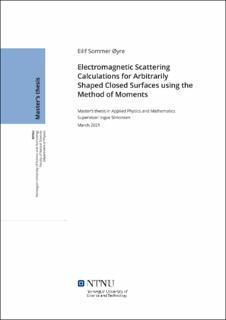| dc.contributor.advisor | Simonsen, Ingve | |
| dc.contributor.author | Øyre, Eilif Sommer | |
| dc.date.accessioned | 2021-09-28T18:40:39Z | |
| dc.date.available | 2021-09-28T18:40:39Z | |
| dc.date.issued | 2021 | |
| dc.identifier | no.ntnu:inspera:69410341:48551845 | |
| dc.identifier.uri | https://hdl.handle.net/11250/2785574 | |
| dc.description.abstract | I denne oppgaven løses Maxwells likninger numerisk for det elektromagnetiske spred-ningsproblemet i to regioner ved bruk av overflateintegrallikninger og momentmeto-den. For å kunne diskretisere de ekvivalente strømmene i overflateintegralliknin-gene, blir RWG basisfunksjoner brukt sammen med Galerkins metode for de vek-tede restene. Ved hjelp av PMCHW-formuleringen kombineres den elektriske ogmagnetiske integrallikningen, og den resulterende matriselikningen blir løst ved LU-dekomponering. Den numeriske implementasjonen ble utført i moderne Fortranved bruk av moduler og objekt-orientert programmering. For å kunne bruke im-plementasjonen til å simulere spredning på en vilkårlig overflate, ble koden somlagrer diskretiseringen av overflaten laget generell og allsidig. På denne måten, vilkoden også kunne brukes til å simulere spredning ved bruk av andre metoder ogbasisfunksjoner.Den numeriske implementasjonen ble testet ut på spredning av en homogenkule og resultatene ble sammenlignet med de fra Mie teorien. Resultatene visteinterferensmønster og symmetriske egenskaper som samsvarte med det vi forven-tet, men energien i systemet var ikke bevart for flere av eksemplene, og resultatenevar ikke tilfredstillende lik de fra Mie teorien. Vi tror dette er grunnet mindre feili implementasjonen som ikke ble funnet som følge av begrenset tid. Likevel, blespredningsimuleringer ble utført på ikkesfæriske overflater, og for en innkommendeelektromagnetisk bølge med bølgelengde på 662 nm, lykkes implementasjonen medå reprodusere lokalisert overflateplasmonresonans for en dipolantenne av gull. I til-legg ble en flate-for-flate tilnærming for evaluering av overflateintegralene prøvd ut.Den viste seg å bruke betydelig mer minne, med reduserte beregningstiden med enfaktor på 20, sammenlignet med en basis-for-basis tilnærming. | |
| dc.description.abstract | The Maxwell equations of electromagnetic theory are numerically solved for the tworegion scattering problem using a surface integral formulation (SIE) and the methodof moments (MoM). The RWG basis function is applied to approximate the equiva-lent currents of the SIEs, and Galerkin’s method is used for the weighted residuals.The electric and magnetic field integral equations are combined using the PMCHW-formulation and the resulting matrix equation is solved by LU-decomposition. Thenumerical methods were implemented using modular programming with an object-oriented approach in modern Fortran, and the numerical framework responsible forrepresenting the discretised surface was designed to be general and versatile, so asto be applicable to scattering surfaces of arbitrary shapes and refractive index, andscattering problems using alternative basis functions and methodology.The implementation was tested with scattering from a homogeneous sphere andthe results were compared to the ones Mie theory. The results from the numericalsimulation showed expected interference patterns and symmetric properties, butfailed to consistently conserve energy and satisfyingly match the Mie solution. Thiswas due to issues in the implementation believed to be minor, but not found becauseof time constraints. However, scattering from a single and multiple nonsphericalobjects was simulated, and the implementation proved successful in reproducinglocal surface plasmon resonance effects for a gold dipole at the incident resonancewavelengthλ= 662nm. Moreover, a face-by-face approach in evaluating the surfaceintegrals was implemented, significantly increasing the memory usage, but reducingthe computing time by a factor of 20, compared to a basis-by-basis approach. | |
| dc.language | eng | |
| dc.publisher | NTNU | |
| dc.title | Electromagnetic Scattering Calculations for Arbitrarily Shaped Closed Surfaces using the Method of Moments | |
| dc.type | Master thesis | |
